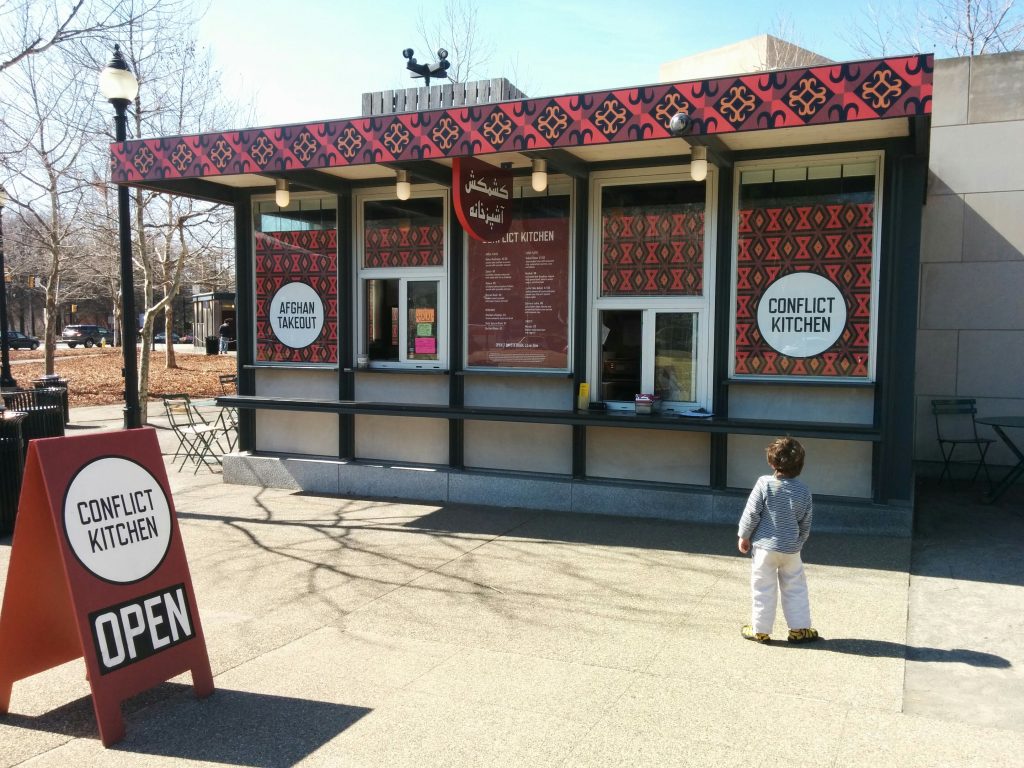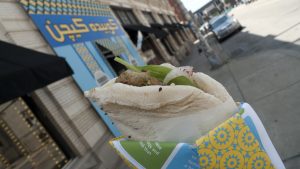Synopsis: The combination of food and performance has a special power to foster conversation. The New York productions of Oh My Sweet Land and the entire premise of Conflict Kitchen demonstrate that when these two are put together, they can impact the way people think about geopolitical issues and conflicts.
Amir Nizar Zuabi’s Oh My Sweet Land does not have a conventional beginning. The reader isn’t introduced to a list of character(s) and the stage directions, which are “no more than suggestions”, are extremely brief (Zuabi, 2). Instead, one opens the first page to see the recipe for kubah, a traditional Syrian dish. It’s slightly confusing and disorienting — the protagonist is cooking throughout the play, but why is the recipe for the dish she’s making the first thing the reader is introduced to? There might not be a clear answer to the question, but what Zuabi is attempting to achieve with such a structure becomes clear as the story progresses. Cooking, as well as the smells and actions that accompany it, informs the entire course of the play. Time and again the reader is reminded of what exactly the nameless protagonist is doing while preparing kubah. This humanizes the experience of the refugees, makes the story more bearable and relatable, and keeps track of the passing time and experiences.

Food and cooking often act as metaphors through Oh My Sweet Land. The kubah has a skin that is compared to human skin multiple times: “In life, unlike with kubah, thick skin is good.” (Zuabi, 15) The state of the kubah when referred to as “cold” and “pale” is a reflection of the state of the refugees and victims of the Syrian conflict. (Zuabi, 10) Even the bubbling of the oil acts as an analogy for the conflict itself. Zuabi uses these common images to help the audience or the reader identify with the challenges that a refugee faces. He recognizes the important role that food plays in each individual’s life and employs its familiar qualities effectively. In Oh My Sweet Land, the protagonist uses food to make a sharp political critique in the non-threatening environment of performance and theater. The kubah ties her back to her homeland, hence evoking a sense of connection both for the actor and for the audience and making a statement about the personal becoming dangerous.
While directing a series of productions of Oh My Sweet Land in New York, Corrine Jaber decided to highlight not the text of the play but the food. Her productions are unique, both because of the spaces that they are performed in and the fact that they involve actual cooking. Jaber describes food as “something that you will always come back to as a human being.” Like Zuabi, she understands food and performance, and the social implications of both. Her productions of Oh My Sweet Land took place in small, domestic kitchens. The intimate setting allowed for not more than 30 audience members that witnessed the preparation of kubah first-hand. Explaining this creative decision, Jaber says, “I know that I have the audience with me as soon as the smells come, and the cooking, because people feel at home in some strange way.” Performance and food serve similar purposes in human life, and the New York productions of Oh My Sweet Land combines the two in a way that creates a safe space for an informed discussion on geopolitically relevant issues.
It is not just the effective combination of food and performance that Jaber emphasizes, but also the role they both play in moments of conflict. Food and performance are inherently tied to culture. They are what people around the world use to identify with and represent their heritage. In situations of war and conflict, safeguarding them becomes as important as safeguarding the tangible elements of society. When people flee to protect themselves, they take with them these forms of culture to both remind themselves of home and preserve it for the future generations. This shared characteristic of food and performance is not something that only the theater industry has noticed and used; other groups also acknowledge this in different ways. The founders of Conflict Kitchen — a restaurant in the heart of Pittsburgh that serves food only from places that the US is in conflict with — also relied upon the potential of food and performance to serve areas and people affected by conflict to run a successful business.

Although the main focus of Conflict Kitchen is to sell food while encouraging conversations about the origins of the same, it incorporates certain elements of performance to achieve a result similar to that of Oh My Sweet Land. One of the founders, Dawn Waleski, visited Colgate University early in 2018 to discuss what she hoped to achieve with Conflict Kitchen and why she thought the idea would work. The essence of her speech was surprisingly similar to Jaber’s interview. She argued that food created a safe atmosphere for people to have conversations they wouldn’t be comfortable having otherwise. Conflict Kitchen did not shy away from advertising exactly what it was selling; the storefronts had the country’s name in bold, the design clearly represented the country, and the food was wrapped in papers that had direct quotes from immigrants of the country. Instead of scaring people away, these aspects actually drew them in. Customers queued up to buy the food and felt a need to discuss the conflict and its implications.

When bringing food and conflict in such close contact with each other, it was impossible for Conflict Kitchen to keep performance out. Using technology, the founders of Conflict Kitchen played around with the definition of the term and then used a broader interpretation of it to foster connections across the globe. The Cuban Speech asked a group of Cubans and Cuban-Americans to discuss what they wanted to hear from President Obama and combined their requests into a proper speech that a President Obama impersonator performed. The Foreigner cultivated conversations between customers and a person living in the area of conflict. A trained actor functioned as a human avatar for the latter by conveying the customer’s questions to them and their answers to the customer while maintaining a level of authenticity. Conflict Kitchen also organized intercontinental dinner parties with half a table in the US and half a table in Iran using Skype, effectively bringing together a group of people who would never have communicated if not for the safety and comfort that their food provided. While these events organized by Conflict Kitchen might not be the conventional way of performance, they definitely have a performative element to it. There is a “transformation of being” in The Foreigner, a “performance sequence” in The Cuban Speech, and a general “intensity” and “audience-performer interactions” in all three. (Schechner and Appel, 4) By an ingenious use of technology to build relationships through performance, Conflict Kitchen successfully brought about a sense of shared space when it didn’t physically exist.
Conclusion: The fact that both Conflict Kitchen and Oh My Sweet Land use food and performance to foster conversations about important conflicts is significant. It proves that food and performance are extremely relevant in our daily lives and have the ability to build real human connections. Both examples are equally inventive in their approach to the interaction between food and performance; from the performance space and the cooking of the kubah in Jaber’s version of Oh My Sweet Land to the use of technology to expand the definition of performance in Conflict Kitchen, the social and political ramifications of the combination of food and performance is evident. It is clear that the tangible effects of food and performance are much more than nutrition and entertainment. The role they play in every individual’s life is almost undefinable and especially in times of conflict, they can be used in a plethora of ways to have a real impact. Whether they serve as a way for people to remain connected to their roots or as a way for outsiders to understand a certain culture or situation, food and performance have certain qualities that cause them to always provide refuge and create an inviting atmosphere that demands an informed conversation.
Resources
Texts
- Conflict Kitchen, www.conflictkitchen.org/about/. Accessed 22 April 2018.
- Schechner, Richard, and Willa Appel. “Introduction.” By Means of Performance: Intercultural Studies of Theatre and Ritual, edited by Richard Schechner and Willa Appel, Cambridge University Press, Cambridge, 1990, pp. 1–7.
- Schiffman, Jean. “2 Ingredients of ‘Oh My Sweet Land’: A Refugee Crisis and Kibbeh”. American Theater. 2017. https://www.americantheatre.org/2017/10/11/2-ingredients-of-oh-my-sweet-land-a-refugee-crisis-and-kibbeh/. Accessed 21 April 2018.
- “The Cuban Speech”. Conflict Kitchen, https://www.conflictkitchen.org/events/the-cuban-speech-publication-and-performance/. Accessed 22 April 2018.
- “The Foreigner”. Conflict Kitchen, https://www.conflictkitchen.org/events/the-foreigner-iran/. Accessed 22 April 2018.
- Zuabi, Amir N. Oh My Sweet Land. Bloomsbury, London, 2014
Media
Images
- Bazel. English: Kibbeh. 3 June 2007. Wikimedia Commons, commons.wikimedia.org/wiki/File:Kibbeh3.jpg#file. Accessed 22 April 2018. Copyright “Basel15”, licensed under CC BY-SA 3.0.
- Ragesoss. The restaurant Conflict Kitchen, decorated for its Afghan menu. 6 April 2014. Wikimedia Commons, commons.wikimedia.org/wiki/File:Conflict_Kitchen_on_Schenley_Plaza,_with_Afghan_menu.jpeg. Accessed 22 April 2018. Licensed under CC BY-SA 3.0.
- leiris202. Conflict Kitchen, Pittsburgh. 12 June, 2016. Flickr, flic.kr/p/JB9caK. Accessed 22 April 2018. Copyright “leiris202”, licensed under CC BY-NC 2.0
- somenametoforget. Conflict Kitchen. 27 July 2010. Flickr, flic.kr/p/8neCAe. Accessed 22 April 2018. Copyright “somenametoforget”, licensed under CC BY-NC-ND 2.0.
Video
- “Corrine Jaber on cooking in war zones – Oh My Sweet Land.” Youtube, uploaded by YoungVicLondon, 13 March 2014, www.youtube.com/watch?v=-9NFNh5ObQs.
- “MaD 2016 影片 Video – Dawn WELESKI ‘衝突廚房’ ‘Conflict Kitchen’.” Youtube, uploaded by MaDAsiaChannel, 5 February 2016, www.youtube.com/watch?v=lVdQMleJb4Q&t=895s.
- “The Cuban Speech.” Vimeo, uploaded by Jon Rubin, 18 December 2013, vimeo.com/82241347.
- “The Foreigner (Palestine).” Vimeo, uploaded by Jon Rubin, vimeo.com/150362628.